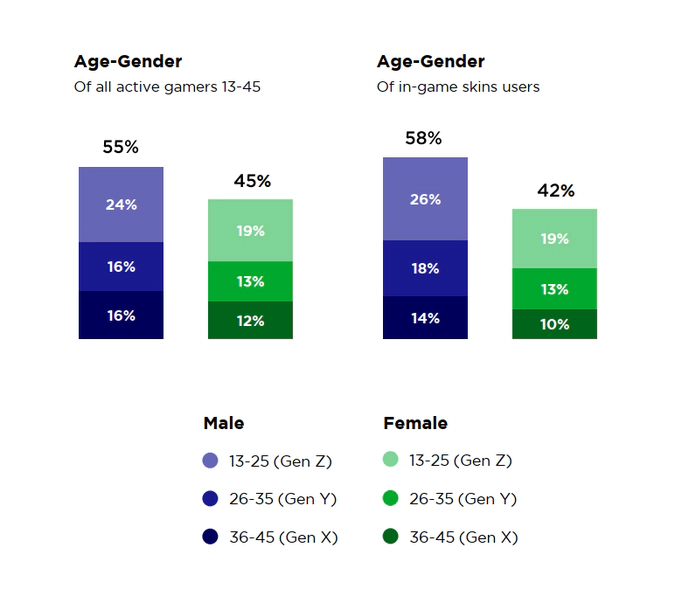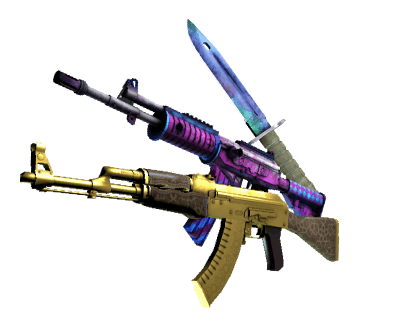In-Game Cosmetics Want to Trade Skins for Real-World Money
Gaming is thriving. There are now 2.7 billion gamers worldwide — a number that will surpass 3 billion in the next three years. Simply put, game-related engagement is higher than ever.
At the same time, the ways gamers engage with the pastime are also evolving, with players interacting with games beyond playing alone: viewing, discussing, owning — the list goes on.
Gaming’s trajectory over the past two decades has also given rise to live-service games, which are often free-to-play and are typically monetized via skins for in-game avatars (also known as skins).
Therefore, it’s no surprise that the vast majority (85%) of active U.S. gamers aged 13-45 are aware of cosmetics in games, according to our <Custom Consumer Research with DMarket.
Young Male Players Are Likelier to Engage with Cosmetics in Games, But Big Spenders Are Older
Cosmetics and skins are now a central part of the online game experience. Right now, the most popular games — including Fortnite, Roblox, League of Legends, and Call of Duty — all feature skins prominently.
Owing to just how prominent skins have become in online games, 43% of U.S.-based active gamers claim they use skins to change the appearance of their avatars/characters, weapons, and vehicles.
Our data shows that those who use skins are likelier to skew younger, and 58% are male. This may be due to the types of games that feature skins mostly prominently.

As mentioned, cosmetics are integral to games like Fortnite, Roblox, Call of Duty, League of Legends, and Rocket League. These titles are incredibly popular worldwide, and while they attract diverse audiences, they especially tend to draw in young males.
Nevertheless, big spenders, who on average spend more than $15 a month on skins, tend to skew older. Armed with more purchasing power but less free time, they’re happy to spend money on skins.
In terms of purchase drivers, they are more likely than low and mid spenders to buy skins to stand out and show off.
Other Monetization Options Also Funnel Players to Skin Ownership
However, simply selling these skins piecemeal is only scratching the surface of publishers’ cosmetic-related monetization.
Another monetization model that’s materialized over the past decade is the battle pass, which is essentially a monthly subscription that challenges players to unlock new content (typically cosmetics).
As you can see below, these monetization methods are now a core part of U.S. core gamers’ access to skins:

Skins now play such a prominent role in Fortnite that almost 80% of Fortnite’s recent players engage with its cosmetics in some way, shape, or form.
As Fortnite has been a trailblazer in cosmetic partnerships with other games, brands, celebrities, and more, this high engagement is no surprise.
In fact, Fortnite is doubling down even further on cosmetics. Epic recently launched a new “Fortnite Crew” subscription on top of its battle pass. Each month, Crew subscribers can unlock new characters skins — as well as V-Bucks with which to buy even more cosmetics.
“In-game skins are a key part of most video games and are the backbone of gaming metaverses,”
says Vlad Panchenko, CEO and Founder of DMarket.
“Fortnite is a shining example of how skins, when combined with real-life brands and influencers, can change the game, and Roblox shows how cosmetics can foster social metaverses within games.’’
As you can see in the image below, Fortnite has the highest share of U.S. players using skins in that game:

Demand for Skin Trading Is High Among Cosmetic-Aware Gamers
Of core U.S. gamers who are aware of skins, 81% would like to get real-world money for their skins and are therefore interested in skin trading. Over two-thirds of the group are unaware of any major skin-trading platforms in the U.S. (including Steam’s Community market, DMarket, OpenSea, and Bitskins).
Crucially, 75% of the players that are interested in skin trading say they’d spend more on skins if they had a monetary value outside of the game. Addressing this need represents a massive opportunity for publishers and skin-trading platforms alike.
“Built on cosmetics, platforms such as Fortnite and Roblox are becoming a crossroads between games, brands, influencers, esports teams, and fans,”
says Vlad Panchenko, CEO and Founder of DMarket.
“They’ve given way to social-hub-like metaverses that were once limited to science fiction. That’s the future of gaming.”
Source: newzoo.com
















